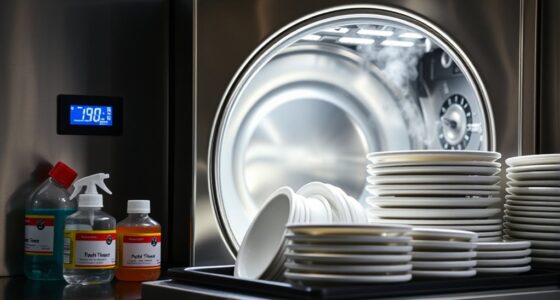To meet carbon monoxide monitoring requirements, you need to install CO detectors in key areas like bedrooms, living rooms, and near fuel appliances, following placement rules to avoid false alarms. Regular testing, maintenance, and calibration are essential for accurate detection. Regulations, such as those from OSHA and NFPA, specify response times and installation standards. Staying compliant guarantees safety, and understanding these guidelines helps you maintain a reliable CO monitoring system. Learn more about how to ensure your spaces stay safe.
Key Takeaways
- CO monitoring requires installation of certified detectors in key areas like bedrooms, living spaces, and near fuel-burning appliances.
- Detectors must meet standards set by organizations such as OSHA and NFPA, ensuring proper sensitivity and response time.
- Regular testing (monthly) and maintenance, including battery replacement and unit calibration, are mandatory for effective monitoring.
- Detectors should be positioned at breathing zone height (~5 feet) and away from drafts, vents, or heat sources to reduce false alarms.
- Documentation of installation, testing, and maintenance activities is essential for compliance and safety audits.
Importance of Carbon Monoxide Awareness

Understanding the importance of carbon monoxide awareness can save lives because this silent, colorless gas is hard to detect without proper equipment. You might not realize you’re exposed until symptoms appear, which can be mistaken for flu or fatigue. Recognizing the risks prompts you to take preventive steps, like installing detectors and maintaining appliances. Being aware of CO dangers helps you identify warning signs early, such as dizziness, headaches, or nausea. Educating yourself about CO’s dangers empowers you to act quickly in an emergency, potentially saving yourself and others. Since CO poisoning can happen quickly and silently, awareness is your first line of defense. Staying informed ensures you understand the importance of monitoring and proper ventilation in your home or workplace. AI security advancements help develop more reliable detection systems, further enhancing safety measures.
Legal and Regulatory Standards for CO Monitoring

Legal and regulatory standards for carbon monoxide monitoring set critical requirements to protect public health and safety. These regulations specify where and how CO detectors must be installed, guaranteeing timely detection in residential and commercial spaces. They also define performance criteria for detectors, such as sensitivity and response time, to guarantee reliability. Compliance often involves regular testing, maintenance, and record-keeping to meet oversight standards. Additionally, understanding the cost of home security systems can help property owners budget for proper installation and ongoing monitoring needs.
Types of CO Detectors and Their Uses
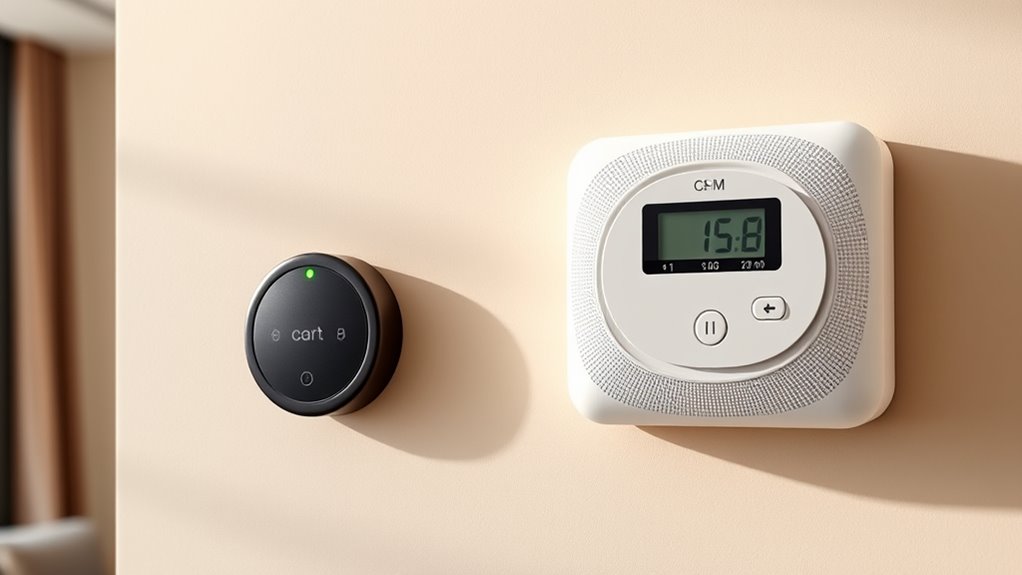
When choosing a CO detector, you’ll notice options like battery-powered and hardwired models, each with its own benefits. Battery-powered detectors are portable and easy to install, while hardwired units offer continuous power and often include backup batteries. Combination detectors, which monitor both smoke and CO, provide added convenience and safety in a single device. Incorporating wall organization solutions can help keep your detectors accessible and well-maintained.
Battery-Powered vs. Hardwired
Choosing between battery-powered and hardwired carbon monoxide detectors depends on your home’s needs and your preferences. Battery-powered detectors are portable, easy to install, and operate during power outages, but they require regular battery replacements. Hardwired detectors are connected directly to your electrical system, offering continuous power and often backup batteries, reducing maintenance. They are ideal for new construction or upgrades, providing a more integrated solution. Consider your home’s size, existing wiring, and your maintenance willingness when choosing.
- Battery-powered units are flexible for rental or temporary setups.
- Hardwired detectors often come with interconnected features, sounding alarms simultaneously.
- Regular testing and maintenance are essential for both types to guarantee safety and proper functioning.
Combination Detectors Advantages
Combination carbon monoxide (CO) detectors offer the advantage of monitoring both CO and smoke in a single device, providing thorough safety coverage. By combining these functions, you reduce the number of alarms needed, simplifying installation and maintenance. These detectors quickly alert you to potential dangers from both smoke and CO leaks, ensuring you respond promptly. They’re especially useful in areas where space is limited or where you want all-encompassing protection without clutter. Many models feature voice alerts and digital displays, making it easier to identify the source of the threat. Using a combination detector also guarantees you won’t forget to replace or test separate devices. Incorporating proper maintenance routines can help ensure these detectors function correctly over time. Overall, they enhance safety, convenience, and peace of mind in your home or workplace.
Placement and Installation Guidelines for CO Monitors

Proper placement of CO monitors is vital for effective detection. You should install them on every level of your home, especially near sleeping areas and potential sources of carbon monoxide. Following best practices guarantees your monitors function reliably when you need them most. Additionally, ensure that your installation process is compliant with safety standards to maximize protection.
Placement Strategies for CO Monitors
Effective placement of CO monitors is essential for ensuring accurate detection of carbon monoxide leaks. You should install monitors at breathing zone height, typically 5 feet above the floor, to capture the most precise readings. Avoid placing them near sources of heat, humidity, or drafts, which can trigger false alarms or mask leaks. Make sure to install monitors in all sleeping areas and attached garages to ensure comprehensive coverage. Proper placement maximizes safety and compliance. Additionally, consider the types of headphone jacks to ensure compatibility with your monitoring devices if needed.
- Install monitors on each level of your home, especially near bedrooms and living areas
- Keep monitors at least 15 feet away from fuel-burning appliances to prevent false alarms
- Avoid placing monitors behind furniture or curtains that could block airflow and reduce detection sensitivity
Installation Best Practices
To guarantee your CO monitors function correctly, it’s important to follow specific installation guidelines. First, mount them at eye level or 5 feet above the floor, avoiding corners and areas with airflow disruptions. Install monitors in rooms where people spend significant time, such as bedrooms and living areas. Avoid installing near vents, windows, or doors that could cause false readings. Use the following table to ensure proper placement:
| Location | Height | Avoid |
|---|---|---|
| Bedroom | 5 feet above floor | Near vents or windows |
| Living Room | Eye level | Direct sunlight |
| Hallways | 5 feet above floor | Areas with airflow drafts |
Proper placement guarantees accurate detection and safety. Additionally, consulting industry best practices for sensor placement can help optimize the effectiveness of your CO monitoring system.
Maintenance and Testing of CO Detection Devices
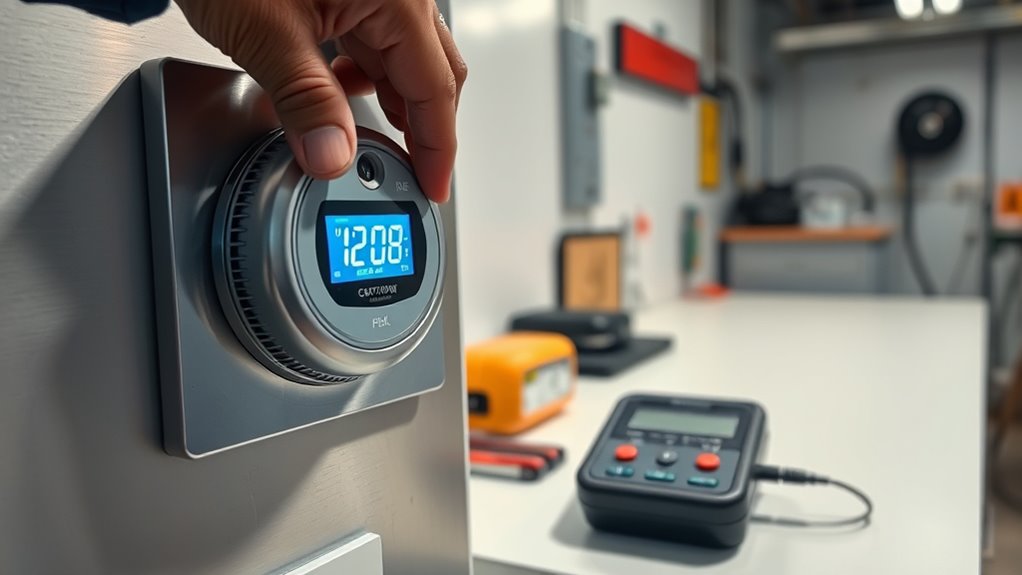
Regular maintenance and testing of CO detection devices are essential to guarantee they function correctly and provide early warnings in case of elevated carbon monoxide levels. You should test your detectors monthly by pressing the test button to ensure they respond properly. Regularly clean the units to remove dust and debris that could interfere with their sensors. Replace batteries at least once a year or as recommended by the manufacturer. Additionally, follow these key practices:
Regularly test, clean, and replace batteries to ensure your CO detectors stay reliable and effective.
- Schedule professional inspections annually to verify device accuracy and sensor health.
- Keep records of maintenance and testing activities for compliance and troubleshooting.
- Replace the entire unit every 5-7 years or according to the manufacturer’s guidelines to ensure reliability.
- Understanding the role of inspirational quotes and heartfelt messages can foster a greater appreciation for safety and family well-being.
Consistent upkeep helps prevent failures and ensures your safety system remains effective.
Specific Requirements for Residential Settings

In residential settings, installing carbon monoxide detectors is a critical safety measure that is often mandated by local building codes. You should place detectors on every floor, especially near bedrooms and sleeping areas, to ensure early warning of dangerous levels. Detectors must be installed at least 15 feet from fuel-burning appliances to prevent false alarms. They should be mounted on the wall or ceiling, following the manufacturer’s instructions for height and placement. Regular testing is essential—test monthly and replace batteries at least once a year. Detectors should be replaced every 5 to 7 years, depending on the manufacturer’s guidelines. Proper installation techniques are crucial to ensure optimal operation and safety. Complying with these specific requirements helps protect you and your family from the dangers of carbon monoxide poisoning.
Monitoring in Commercial and Industrial Environments

When setting up CO monitoring in commercial and industrial spaces, you need to carefully consider equipment placement to guarantee accurate detection. Compliance with regulatory standards guides where and how you install sensors to protect workers and meet legal requirements. By focusing on these strategies, you can create a safer environment and stay within the necessary guidelines.
Equipment Placement Strategies
Effective equipment placement is essential for accurate carbon monoxide monitoring in commercial and industrial environments. Proper placement ensures reliable detection, timely alerts, and safety compliance. You should position sensors where CO is most likely to accumulate or originate, such as near fuel-burning appliances, vents, or enclosed spaces. Avoid placing detectors near fresh air sources, vents, or areas with high airflow, as these can dilute CO levels and cause false readings. Consider the height at which you install monitors—CO tends to settle low, so placement at breathing zone level is ideal. Regularly inspect and calibrate sensors, and document placements to ensure ongoing effectiveness. Thoughtful positioning minimizes blind spots and maximizes the safety benefits of your monitoring system. Additionally, understanding the benefits of raw food can inform safer food handling practices, just as proper sensor placement enhances safety monitoring.
Regulatory Compliance Standards
Proper equipment placement plays an essential role in meeting regulatory requirements for carbon monoxide monitoring. You must guarantee detectors are installed according to standards set by authorities like OSHA, NFPA, and local regulations. This means placing detectors in all areas where people work or gather, especially near fuel-burning appliances and ventilation points. Regular calibration and maintenance are mandatory to keep detectors functioning correctly. You’re also responsible for documenting compliance efforts, including installation locations and maintenance logs. Failing to meet these standards can lead to hefty fines and increased safety risks. To stay compliant, review applicable codes regularly, and keep records updated. By adhering to these standards, you ensure a safer environment and avoid penalties associated with non-compliance.
Response Procedures When CO Is Detected
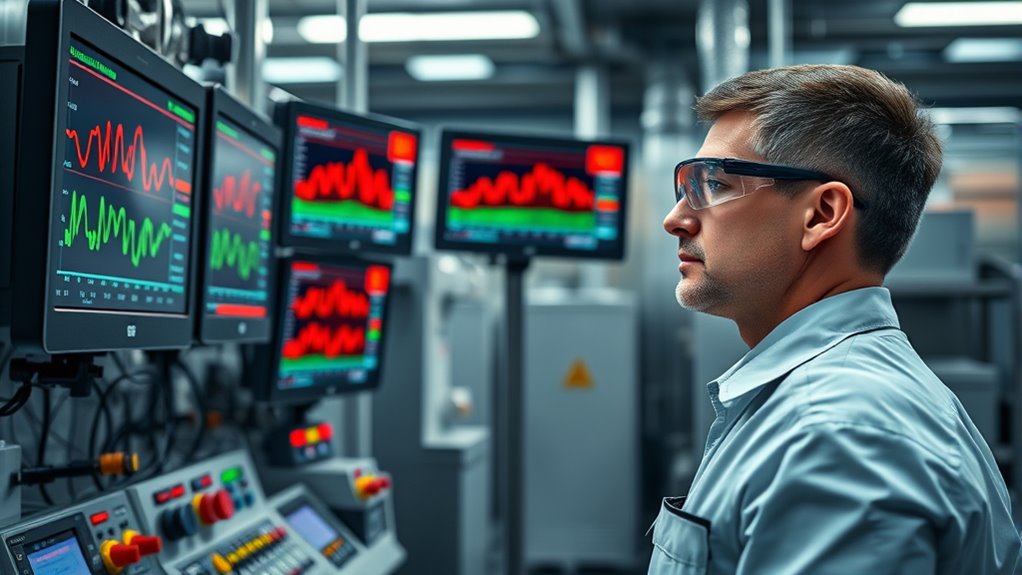
If you detect elevated levels of carbon monoxide (CO), taking immediate action is essential to protect yourself and others. First, activate the building’s emergency ventilation system to disperse the gas. Then, evacuate everyone from the area promptly, avoiding re-entry until professionals confirm safety. Call emergency services or the appropriate authorities to report the incident and request assistance.
- Shut off any potential CO sources, such as appliances or heaters, if it’s safe to do so.
- Use portable CO detectors to identify the affected zones and confirm the presence of CO.
- Document the incident details for future reference and compliance purposes.
Rapid response can prevent serious health effects and save lives, so always prioritize swift, decisive action.
Recordkeeping and Compliance Documentation
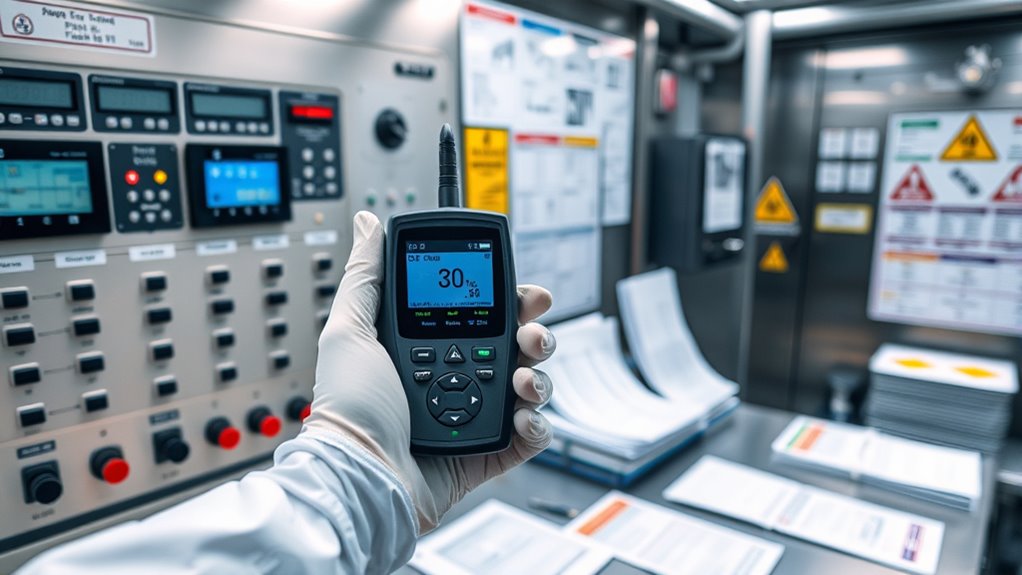
Maintaining accurate records of CO monitoring activities is essential for demonstrating compliance with safety regulations and ensuring ongoing safety measures. You should log each monitoring session, including date, time, location, and results. Keep detailed documentation of calibration and maintenance of monitoring equipment to verify correctness. Store records securely to facilitate inspections and audits. Regularly review logs to identify trends or potential issues early. Proper documentation not only proves compliance but also enhances safety by providing a clear history of monitoring efforts. Make sure your records are organized, legible, and easily accessible. This diligent recordkeeping ensures that you meet regulatory requirements and can quickly respond to any CO-related concerns or investigations. Consistent documentation is key to maintaining a safe environment and regulatory adherence.
Advancements in CO Monitoring Technology
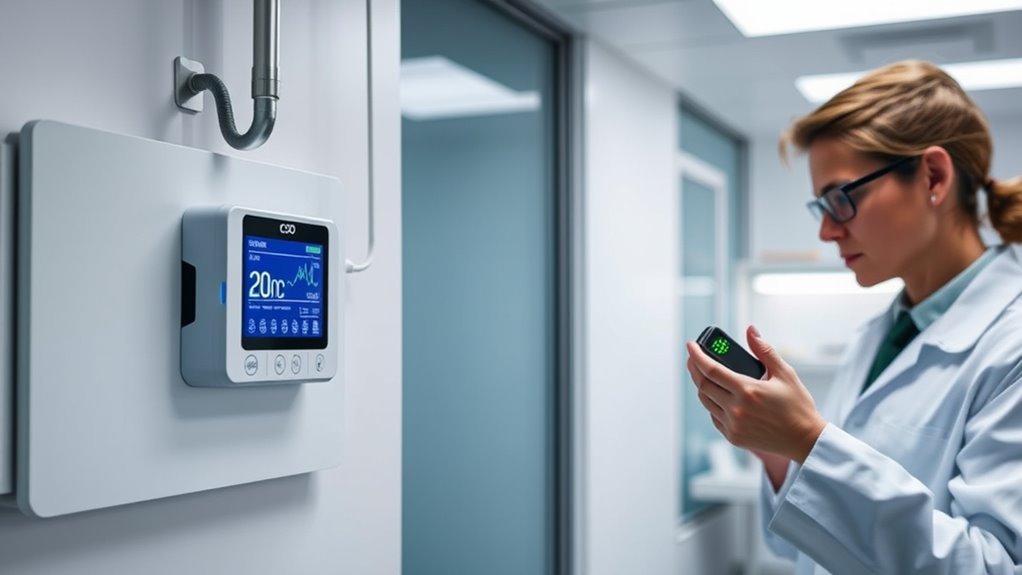
Recent innovations in carbon monoxide monitoring technology have considerably improved the accuracy, responsiveness, and ease of use of detection systems. Modern sensors now detect lower CO concentrations more quickly, reducing the risk of exposure. Portable devices are more compact and user-friendly, making regular testing simpler. Connectivity features, like wireless alerts and integration with smart home systems, provide real-time updates and remote monitoring. These advancements mean you can respond faster to potential hazards and maintain compliance more easily.
Recent CO monitoring innovations enhance accuracy, speed, and user-friendliness for safer, smarter detection.
- Use of electrochemical sensors for precise measurements
- Integration of IoT technology for real-time data sharing
- Enhanced battery life and durability for long-term reliability
Frequently Asked Questions
How Often Should CO Detectors Be Replaced?
You should replace your carbon monoxide detectors every 5 to 7 years, depending on the manufacturer’s instructions. Regularly test the unit monthly to guarantee it works properly. If the detector chirps or shows a low-battery warning, replace the batteries immediately, and consider replacing the entire unit if it’s over the recommended age. Proper maintenance keeps you safe and helps prevent carbon monoxide poisoning.
Are There Differences in CO Monitoring for Apartments Versus Houses?
Think of your home as a ship sailing safely. You might wonder if apartments and houses need different CO monitoring. The truth is, both should have reliable detectors to keep everyone safe, but regulations can vary. Apartments often have shared spaces, so monitoring might be more centralized. In houses, you can place detectors more freely. Ultimately, follow local codes and guarantee your detectors are in the right spots for maximum protection.
What Are the Signs of CO Poisoning to Watch For?
You should watch for symptoms of CO poisoning like headaches, dizziness, weakness, nausea, or confusion. If you or others experience these signs, get fresh air immediately and seek medical help. CO is colorless and odorless, so paying attention to symptoms is vital. Regularly check your carbon monoxide detectors, and make sure they’re functioning properly to prevent dangerous buildup. Stay alert for signs and act quickly to keep everyone safe.
Can CO Detectors Be Interconnected for Enhanced Safety?
They say “a chain is only as strong as its weakest link,” so interconnected CO detectors substantially boost your safety. By wiring detectors together, when one senses dangerous CO levels, all alarms sound simultaneously, giving you precious extra seconds to act. This setup ensures you’re alerted promptly, no matter where you are in your home, providing peace of mind and a coordinated response during potential CO emergencies.
What Funding Options Are Available for Installing CO Monitoring Systems?
You might be wondering about funding options for installing CO monitoring systems. You can explore local grants, state assistance programs, or federal incentives designed for safety improvements. Some utility companies also offer rebates for installing safety devices. Additionally, check with community organizations or non-profits that support home safety upgrades. By researching these options, you can find financial support to help keep your home safe without a heavy upfront cost.
Conclusion
By understanding and following CO monitoring requirements, you’re building a safety net that catches dangers before they strike. Think of it as planting a vigilant guard dog in your home or workplace—always alert, always ready. Staying proactive with proper installation, maintenance, and response plans transforms potential hazards into manageable risks. Ultimately, your commitment to CO awareness creates a shield that keeps everyone safe, turning the invisible threat into a manageable challenge you confidently face.





